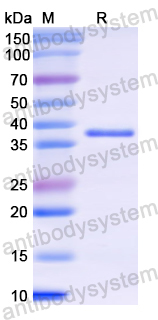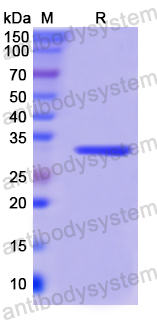Catalog No.
YHC91601
Expression system
E. coli
Species
Homo sapiens (Human)
Protein length
Glu198-Ser514
Predicted molecular weight
38.83 kDa
Nature
Recombinant
Endotoxin level
Please contact with the lab for this information.
Purity
>90% as determined by SDS-PAGE.
Accession
P12035
Applications
ELISA, Immunogen, SDS-PAGE, WB, Bioactivity testing in progress
Form
Lyophilized
Storage buffer
Lyophilized from a solution in PBS pH 7.4, 0.02% NLS, 1mM EDTA, 4% Trehalose, 1% Mannitol.
Reconstitution
Reconstitute in sterile water for a stock solution. A copy of datasheet will be provided with the products, please refer to it for details.
Shipping
In general, proteins are provided as lyophilized powder/frozen liquid. They are shipped out with dry ice/blue ice unless customers require otherwise.
Stability and Storage
Use a manual defrost freezer and avoid repeated freeze thaw cycles. Store at 2 to 8°C for frequent use. Store at -20 to -80°C for twelve months from the date of receipt.
Alternative Names
Keratin, type II cytoskeletal 3, 65 kDa cytokeratin, KRT3, Type-II keratin Kb3, CK-3, K3, Keratin-3, Cytokeratin-3
Gene expression study in the siRNA based aniridia cell model and in primary aniridia limbal epithelial cells following duloxetine and ritanserin treatment., PMID:40493651
Effect of isolated keratin 3 knockdown on gene expression of primary limbal epithelial cells without and with inflammatory stimuli., PMID:40334825
Effect of MiRNA 204-5P Mimics and Lipopolysaccharide-Induced Inflammation on Transcription Factor Levels, Cell Maintenance, and Retinoic Acid Signaling in Primary Limbal Epithelial Cells., PMID:40332443
Deep Saliva Proteomics Elucidating the Pathogenesis of Early Childhood Caries and Identifying Biomarkers for Early Prediction., PMID:39681551
Regulation of corneal epithelial differentiation: miR-141-3p promotes the arrest of cell proliferation and enhances the expression of terminal phenotype., PMID:39642122
Histological, histochemical, and immunohistochemical characterization of NANOULCOR nanostructured fibrin-agarose human cornea substitutes generated by tissue engineering., PMID:39538248
Application of quantitative proteomics to discover biomarkers for tick resistance in cattle., PMID:36793724
ETS1-HMGA2 Axis Promotes Human Limbal Epithelial Stem Cell Proliferation., PMID:36652264
In situ transduction of cells in human corneal limbus using adeno-associated viruses: an ex vivo study., PMID:36577775
Maltese Allelic Variants in Corneal Dystrophy Genes in a Worldwide Setting., PMID:35799042
Epithelial Cell-Derived Extracellular Vesicles Trigger the Differentiation of Two Epithelial Cell Lines., PMID:35163646
Similarities in DSG1 and KRT3 Downregulation through Retinoic Acid Treatment and PAX6 Knockdown Related Expression Profiles: Does PAX6 Affect RA Signaling in Limbal Epithelial Cells?, PMID:34827649
A 3D Polymer Scaffold Platform for Enhanced in vitro Culture of Human & Rabbit Buccal Epithelial Cells for Cell Therapies., PMID:33835468
Coexistence of Meesmann Corneal Dystrophy and a Pseudo-Unilateral Lattice Corneal Dystrophy in a Patient With a Novel Pathogenic Variant in the Keratin K3 Gene: A Case Report., PMID:33346999
Transcriptional profiles along cell programming into corneal epithelial differentiation., PMID:33098888
Keratin 12 mRNA expression could serve as an early corneal marker for limbal explant cultures., PMID:32016711
HCE-T cell line lacks cornea-specific differentiation markers compared to primary limbal epithelial cells and differentiated corneal epithelium., PMID:31927639
In Vitro Cultivation of Limbal Epithelial Stem Cells on Surface-Modified Crosslinked Collagen Scaffolds., PMID:31065280
In vivo histology and p.L132V mutation in KRT12 gene in Japanese patients with Meesmann corneal dystrophy., PMID:30535821
Expression of retinoic acid signaling components ADH7 and ALDH1A1 is reduced in aniridia limbal epithelial cells and a siRNA primary cell based aniridia model., PMID:30292490
Human aniridia limbal epithelial cells lack expression of keratins K3 and K12., PMID:29162348
Sphere-forming cells from peripheral cornea demonstrate the ability to repopulate the ocular surface., PMID:27250558
Corneal recovery in a rabbit limbal stem cell deficiency model by autologous grafts of tertiary outgrowths from cultivated limbal biopsy explants., PMID:26937166
PAX6 Isoforms, along with Reprogramming Factors, Differentially Regulate the Induction of Cornea-specific Genes., PMID:26899008
Identification of presumed pathogenic KRT3 and KRT12 gene mutations associated with Meesmann corneal dystrophy., PMID:26788030
Keratin 12 missense mutation induces the unfolded protein response and apoptosis in Meesmann epithelial corneal dystrophy., PMID:26758872
Inhibition of TGFβ cell signaling for limbal explant culture in serumless, defined xeno-free conditions., PMID:26554938
Differentiation of Stem Cells From Human Exfoliated Deciduous Teeth Toward a Phenotype of Corneal Epithelium In Vitro., PMID:26165791
Quantum dot labeling and tracking of cultured limbal epithelial cell transplants in vitro., PMID:26024089
Cellular Response of Limbal Stem Cells on Polycaprolactone Nanofibrous Scaffolds for Ocular Epithelial Regeneration., PMID:25897888
Cultivation and phenotypic characterization of rabbit epithelial cells expanded ex vivo from fresh and cryopreserved limbal and oral mucosal explants., PMID:24833207
Effect of porcine chondrocyte-derived extracellular matrix on the pterygium in mouse model., PMID:24562465
Reconstruction of limbal stem cell deficient corneal surface with induced human bone marrow mesenchymal stem cells on amniotic membrane., PMID:24286920
KRT12 mutations and in vivo confocal microscopy in two Japanese families with Meesmann corneal dystrophy., PMID:24099278
Suitability of human Tenon's fibroblasts as feeder cells for culturing human limbal epithelial stem cells., PMID:23832306
Characterization of corneal stromal stem cells with the potential for epithelial transdifferentiation., PMID:23800436
Autosomal-dominant Meesmann epithelial corneal dystrophy without an exon mutation in the keratin-3 or keratin-12 gene in a Chinese family., PMID:23569037
Comparison of culture media for ex vivo cultivation of limbal epithelial progenitor cells., PMID:23378720
Severe Meesmann's epithelial corneal dystrophy phenotype due to a missense mutation in the helix-initiation motif of keratin 12., PMID:23222558
Comparative analysis of tumor markers and evaluation of their predictive value in patients with colorectal cancer., PMID:22414974
Composition and proteolytic processing of corneal deposits associated with mutations in the TGFBI gene., PMID:22155582
Changes in corneal basal epithelial phenotypes in an altered basement membrane., PMID:21264285
The TGFBI R555W mutation induces a new granular corneal dystrophy type I phenotype., PMID:21264234
MUC16 as a sensitive and specific marker for epithelial downgrowth., PMID:21060041
Umbilical mass., PMID:20883694
Identification of a novel mutation in the cornea specific keratin 12 gene causing Meesmann's corneal dystrophy in a German family., PMID:20577595
Ocular surface reconstruction with autologous nasal mucosa in cicatricial ocular surface disease., PMID:19875092
Immunohistochemical expression of epithelial cell markers in corneas with congenital aniridia and ocular cicatrizing pemphigoid., PMID:19558573
Greater growth potential of p63-positive epithelial cell clusters maintained in human limbal epithelial sheets., PMID:19324845
Merkel cell carcinoma of the alveolar mucosa in a young adult: a rare case report., PMID:19167791


